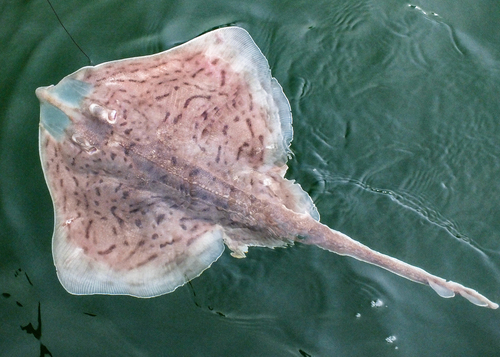
Clearnose Skate
The Atlantic bluefin tuna (Thunnus thynnus) is a highly migratory, large, pelagic fish renowned for its size, speed, and commercial value. As one of the ocean's top predators, it plays a crucial role in marine ecosystems. However, its prized status in cuisine, particularly sushi, has led to significant overfishing, making it an endangered species.
5 8 years
Lifespan
75 cm
Length
Endangered
Conservation Status
null km/h
Swimming speed
Carnivorous
Diet
Local Migration
Migration
Appearance Overview
The Atlantic bluefin tuna is a large, torpedo-shaped fish with a streamlined body built for speed and endurance.
Color
Dark metallic blue on top, with a silvery-white underside
Fins
Two dorsal fins, the first depressible; small finlets running down the back and belly towards the tail
Body Shape
Torpedo-shaped and streamlined
Length
Typically up to 10 feet (3 meters), but can reach up to 13 feet (4 meters)
Weight
Commonly up to 550 lbs (250 kg), but can reach over 1,500 lbs (680 kg)
Diet
Carnivorous, feeding on a variety of fish, squid, crustaceans, and eels.
Feeding Behavior
Highly active predator, using speed and powerful muscles to chase down prey. They often feed cooperatively, herding and surrounding schools of smaller fish.
Social Behavior
Forms large schools, especially during migration and spawning. Schools can be mixed with other tuna species, but generally segregate by size. They are highly migratory and travel great distances to find food and reproduce.
Commercial Relevance
Extremely high value, especially in the sushi and sashimi markets. Its rich, fatty flesh is considered a delicacy, particularly in Japan, driving high prices and demand.
Conservation measures
Subject to international fishing quotas and regulations set by organizations like ICCAT (International Commission for the Conservation of Atlantic Tunas). Measures include catch limits, minimum size restrictions, and monitoring programs.
Status
Endangered (IUCN)
Threats
Historically, severe overfishing has drastically reduced populations. Other threats include bycatch in fishing gear, habitat degradation, and the impacts of climate change on prey availability and spawning grounds.
Habitat Distribution
Depth Range
Typically found from the surface to depths of 500-1,000 meters (1,640-3,280 feet), depending on the season and location.
Geographic Range
Found throughout the North Atlantic Ocean, including the Mediterranean Sea. Key areas include the waters off North America, Europe, and North Africa.
Preferred Environment
Prefers temperate and subtropical waters. They are pelagic, meaning they live in the open ocean rather than near the seabed.
Reproduction and Life Cycle
Breeding Habits
Spawns in two main areas: the Gulf of Mexico and the Mediterranean Sea. Spawning occurs in warm waters, typically from April to June in the Gulf of Mexico and May to July in the Mediterranean.
Development Stages
Eggs hatch into larvae, which are planktonic and drift with the currents. They grow rapidly, developing into juveniles and eventually adults. Growth rates vary depending on environmental conditions and food availability.
Fecundity
Highly fecund; a single female can produce up to 30 million eggs per spawning season. The eggs are released into the water column and fertilized externally.
Maturity Age
Reaches sexual maturity relatively late, typically between 4-8 years, depending on the population and environmental conditions.
Faqs about Clearnose Skate
Where are Atlantic bluefin tuna found?
Atlantic bluefin tuna are found in the Atlantic Ocean, ranging from the cold waters of the North Atlantic to the tropical waters of the Gulf of Mexico and the Mediterranean Sea.
What do Atlantic bluefin tuna eat?
Atlantic bluefin tuna are apex predators, feeding on a variety of smaller fish, squid, crustaceans, and eels.
How long do Atlantic bluefin tuna live?
Atlantic bluefin tuna can live up to 40 years, although this is less common now due to fishing pressure.
Do Atlantic bluefin tuna migrate?
Yes, they are highly migratory, traveling long distances across the Atlantic Ocean for feeding and spawning.
What are the main threats to Atlantic bluefin tuna?
They are primarily threatened by overfishing, which has significantly depleted their populations. Other threats include bycatch and habitat degradation.
Copyright @ Nature Style Limited. All Rights Reserved.
 English
English